The $12 “Gongkai” Phone
How cheap can you make a phone?
Recently, I paid $12 at Mingtong Digital Mall for a complete phone, featuring quad-band GSM, Bluetooth, MP3 playback, and an OLED display plus keypad for the UI. Simple, but functional; nothing compared to a smartphone, but useful if you’re going out and worried about getting your primary phone wet or stolen.
Also, it would certainly find an appreciative audience in impoverished and developing nations.
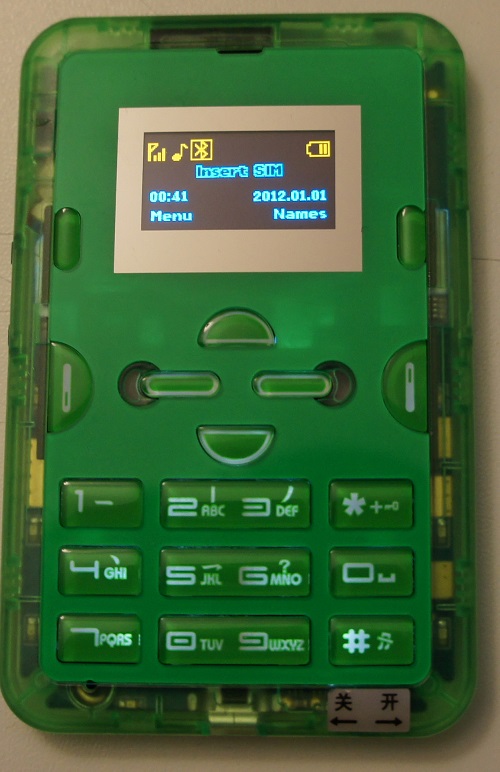
$12 is the price paid for a single quantity retail, contract-free, non-promotional, unlocked phone — in a box with charger, protective silicone sleeve, and cable. In other words, the production cost of this phone is somewhere below the retail price of $12. Rumors place it below $10.
This is a really amazing price point. That’s about the price of a large Domino’s cheese pizza, or a decent glass of wine in a restaurant. Or, compared to an Arduino Uno (admittedly a little unfair, but humor me):
| Spec | This phone | Arduino Uno |
|---|---|---|
| Price | $12 | $29 |
| CPU speed | 260 MHz, 32-bit | 16 MHz, 8-bit |
| RAM | 8MiB | 2.5kiB |
| Interfaces | USB, microSD, SIM | USB |
| Wireless | Quadband GSM, Bluetooth | – |
| Power | Li-Poly battery, includes adapter | External, no adapter |
| Display | Two-color OLED | – |
How is this possible? I don’t have the answers, but it’s something I’m trying to learn. A teardown yields a few hints.
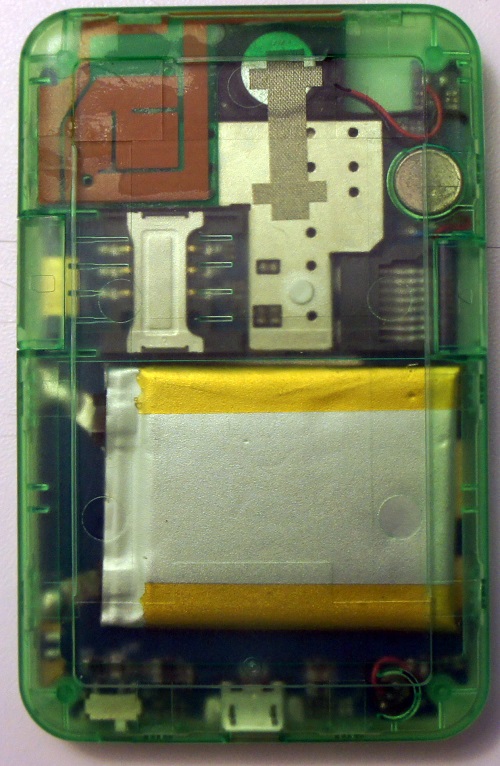
First, there are no screws. The whole case snaps together.
Also, there are (almost) no connectors on the inside. Everything from the display to the battery is soldered directly to the board; for shipping and storage, you get to flip a switch to hard-disconnect the battery. And, as best as I can tell, the battery also has no secondary protection circuit.
The Bluetooth antenna is nothing more than a small length of wire, seen on the lower left below.
Still, the phone features accoutrements such as a back-lit keypad and decorative lights around the edge.
The electronics consists of just two major ICs: the Mediatek MT6250DA, and a Vanchip VC5276. Of course, with price competition like this, Western firms are suing to protect ground: Vanchip is in a bit of a legal tussle with RF Micro, and Mediatek has also been subject to a few lawsuits of its own.
The MT6250 is rumored to sell in volume for under $2. I was able to anecdotally confirm the price by buying a couple of pieces on cut-tape from a retail broker for about $2.10 each. [No, I will not broker these chips or this phone for you…]
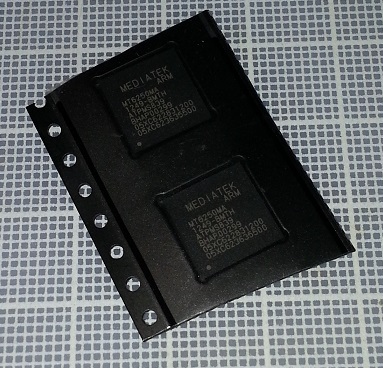
That beats the best price I’ve ever been able to get on an ATMega of the types used in an Arduino.
Of course, you can’t just call up Mediatek and buy these; and it’s extremely difficult to engage with them “going through the front door” to do a design. Don’t even bother; they won’t return your calls.
However, if you know a bit of Chinese, and know the right websites to go to, you can download schematics, board layouts, and software utilities for something rather similar to this phone…”for free”. I could, in theory, at this point attempt to build a version of this phone for myself, with minimal cash investment. It feels like open-source, but it’s not: it’s a different kind of open ecosystem.
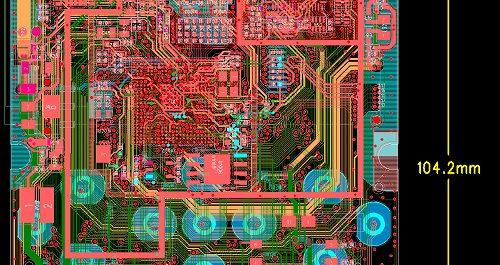
Introducing Gongkai
Welcome to the Galapagos of Chinese “open” source. I call it “gongkai” (公开). Gongkai is the transliteration of “open” as applied to “open source”. I feel it deserves a term of its own, as the phenomenon has grown beyond the so-called “shanzhai” (山寨) and is becoming a self-sustaining innovation ecosystem of its own.
Just as the Galapagos Islands is a unique biological ecosystem evolved in the absence of continental species, gongkai is a unique innovation ecosystem evolved with little western influence, thanks to political, language, and cultural isolation.
Of course, just as the Galapagos was seeded by hardy species that found their way to the islands, gongkai was also seeded by hardy ideas that came from the west. These ideas fell on the fertile minds of the Pearl River delta, took root, and are evolving. Significantly, gongkai isn’t a totally lawless free-for-all. It’s a network of ideas, spread peer-to-peer, with certain rules to enforce sharing and to prevent leeching. It’s very different from Western IP concepts, but I’m trying to have an open mind about it.
I’m curious to study this new gongkai ecosystem. For sure, there will be critics who adhere to the tenets of Western IP law that will summarily reject the notion of alternate systems that can nourish innovation and entrepreneurship. On the other hand, it’s these tenets that lock open hardware into technology several generations old, as we wait for patents to expire and NDAs to lift before gaining access to the latest greatest technology. After all, 20 years is an eternity in high tech.
I hope there will be a few open-minded individuals who can accept an exploration of the gongkai Galapagos. Perhaps someday we can understand — and maybe even learn from — the ecosystem that produced the miracle of the $12 gongkai phone.
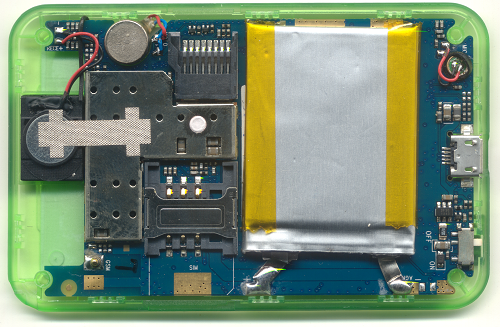
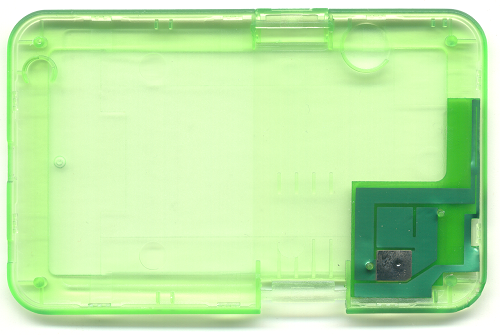
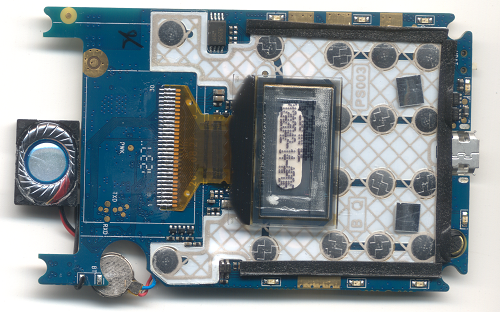
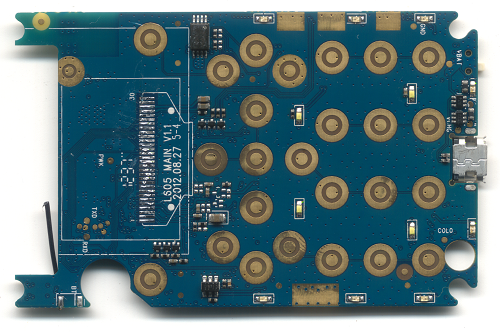
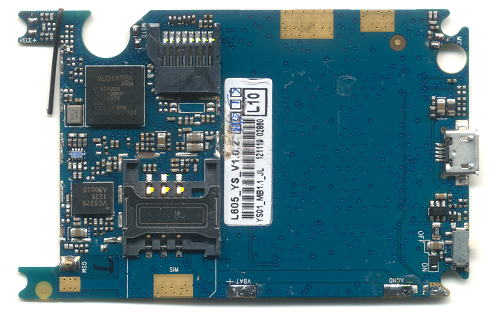
Heard about you on a podcast from USA. Great stuff Bunnie.
You might be interested to compare how Nokia did it with their 105. This feature-phone sells for $20 retail.
There is a video teardown on http://electronics360.globalspec.com/
BOM: $11.00
Manufacturing: $0.70
Box, charger, etc.: $2.50
Hi would you be able to resell these? I’m interested in getting a few at $12 for hacking and projects
You think he would resell them to you at the price he paid? Are you 12?
They’re on Amazon for around US$10.
under what name do i find them on amazon?
This simple and cheap device would be not only а temporary substitute for the primary phone (i.e., smartphone), but a good phone for elderly people.
/once I was struggling to find ANY phone for my grandmother. Anything NOT too complicated (eventually found one Doro – proved to be a very stupid phone) on the market was still was around 50…60€.
re: “Hi would you be able to resell these?”
– Supposedly, the answer is “no”/”not interested”. 8(
Thank you very much. Great article
[…] X (lol). Not that it wouldn’t have taken me much less time to take the whole thing apart. (Here’s bunnie doing that to a different phone from the same marketplace.) It has a little PCB sandwiched on top of another PCB, which I for some reason quite […]
Bunnie,
As you’ve probably seen, this is no longer the cheapest phone at Mingtong. I bought three $7 phones there in April. Disappointingly, at least to me, they look a little more polished than this beastie. I posted some photos of the innards on the Wiki at HacDC, where I left one for examination and hackage:
http://wiki.hacdc.org/index.php/$7_cell_phone
I showed this to my girlfriend last night and it made sense
$12 and phone with 260 MHz, 32-bit processing!
Great buy
Can actually start small scale business in Asian countries with it :)
Thank you very much. Great article
$10 dual-freq cellphones have been around for at least ten years. I bought one in dubai once without considering beforehand that it would not work on US cell frequencies.
What was the cheapest Android smartphone available, for comparison? Just curious as I am running a ZTE Concord II purchased new here in the US from MetroPCS for $20.
One comment about ATMega parts mentioned in the FA. Not a good comparison. Currently they twice as expensive as a comparable arm based processor. The real advantages they still have are
1. Very very low power consumption,
2. And simple and easy to understand peripherals, meaning cheap in expensive engineering time to understand
3. Generally simple, work out of the box, and cheap dev tools.
But if you’re shipping 10k/month the $2 premium would pay for two full time dev’s
Very nice article. I really love it :)
wat the phone without vibrations..
You can get CANCER with one of these…
You can probably get cancer with any of them, but I doubt this phone is more dangerous than any other phone: just think about it, it just have bluetooth and a regular antena, while other phones have more antennas (wifi, radio) == more emmiters on various frequencies. They say that they do affect humans, but I’m not sure about the cancer part.
Your not supposed to eat it.
Hi Bunnie,
Do you have any info about the OLED display?
I’m in organic electronics field ;)
Thanks!
That looks like the display used in the Sandisk Sansa Clip/Clip+ they have the same top yellow section with blue underneath. Look up some pictures and you will see the resemblance.
Does it have a 3.5mm headset jack?
Such a great story I had to steal the whole thing.
The price difference between the phone and the arduino probably has a lot to do with volume. Arudinos sell, what? Thousands of units? The phone will likely sell hundreds of thousands, eh?
[…] The $12 Phone […]
[…] Super Cheap Phone…really, really cheap […]
[…] a year and a half ago, I wrote about a $12 “Gongkai” cell phone (pictured above) that I stumbled across in the markets of Shenzhen, China. My most striking […]
I found a phone similar to this one on Aliexpres:
http://www.aliexpress.com/item/Russian-Keyboard-Original-AIEK-M5-Card-Mobile-Phone-4-5mm-Ultra-Thin-Pocket-Mini-Phone/1966910384.html
[…] the shanzhai approach to sharing — like open source, but not quite — a name: “gongkai“. In a long and fascinating new post, he explains the background to the term: […]
[…] the shanzhai approach to sharing — like open source, but not quite — a name: “gongkai“. In a long and fascinating new post, he explains the background to the term: […]
The lenovo k900 is an excellent quality smartphone. It combines elegance, speed and superiority in one phone. This phone is a great achievement in the company’s history, since the lenovo k900 is their first smartphone that reached European and American markets. Normally, Lenovo’s products are made for the Chinese and Asian markets, both for personal and commercial use.
The company has made the phone to break in the “Western market”, however it has been made and produced in China and distributed from Hong Kong. Most of the Chinese phones are replicas, low quality, often called “garbage” by the people. But the 30-40% of the smartphones produced in the country are branded, so they are not clones of other smartphones. The cell phones’ components are made in China too, however the lenovo k900 is made from quality materials. For example its CPU is an Intel Atom, and as most of the people know, Intel is one of the leader central unit processor companies in the world and their products are well known of their great quality.
Finally, the lenovo k900 is a great, unique smartphone, its performance, power, low price and elegance makes the phone Lenovo’s new flagship cell phone.
[…] The SOC for this module is a Mediatek MT6260SA, which is closely related to the processor in the $12 Chinese cellphone that Bunnie Huang wrote about a few years ago. Bunnie has a write-up about this line of chips (and some more really neat X-Rays) […]
So I was looking for stuff when I stumbled upon this, I think Q1 qmart is similar to the gongkai here, http://www.ebay.com/itm/191467919439. The chip Mediatek MT6260 is available for $4 from aliexpress.
Hello!
In similar devices, an earphones wire used as FM Antenna, but this phone has no earphone jack.
Please, suggest me, where have I to connect antenna in order to hear FM Radio?
Thank you!
[…] a year and a half ago, I discovered this $12 “Gongkai” cell phone (pictured above) in the markets of Shenzhen, China. My most striking impression was that Chinese […]
[…] a year and a half ago, I discovered this $12 “Gongkai” cell phone (pictured above) in the markets of Shenzhen, China. My most striking impression was that Chinese […]
[…] a year and a half ago, I discovered this $ 12 “Gongkai” cell phone (pictured above) in the markets of Shenzhen, China. My most striking impression was that Chinese […]
[…] a year and a half ago, I discovered this $12 “Gongkai” cell phone (pictured above) in the markets of Shenzhen, China. My most striking impression was that Chinese […]
[…] a year and a half ago, I discovered this $12 “Gongkai” cell phone (pictured above) in the markets of Shenzhen, China. My most striking impression was that Chinese […]
[…] a year and a half ago, I discovered this $12 “Gongkai” cell phone (pictured above) in the markets of Shenzhen, China. My most striking impression was that Chinese […]
[…] a year and a half ago, I discovered this $12 “Gongkai” cell phone (pictured above) in the markets of Shenzhen, China. My most striking impression was that Chinese […]
[…] a year and a half ago, I discovered this $12 ?Gongkai? cell phone (pictured above) in the markets of Shenzhen, China. My most striking impression was that Chinese […]
[…] a year and a half ago, I discovered this $US12 “Gongkai” mobile phone (pictured above) in the markets of Shenzhen, China. My most striking impression was that Chinese […]
[…] a year and a half ago, I discovered this $12 “Gongkai” cell phone (pictured above) in the markets of Shenzhen, China. My most striking impression was that Chinese […]
I can`t read the most part o text, is site down?
[…] of having the typical licensing everyone uses, China has a ‘Gongkai’ IP model, whereby information is shared for a fee wherever and whenever, but not necessarily following a law or rule. This means that anyone can simply grab a design blueprint of a device for a fee and manufacture a […]
http://mashable.com/2015/11/16/walmart-10-android-phone/#C8.lldC0zGqx
“Yes, throwaway smartphones have arrived, and Walmart’s selling them for $10 ($9.82 if you’re really counting the pennies). As spotted by Motherboard, TracFone’s Lucky LG16, an LG-made smartphone, has better specs than the original iPhone.”
[…] The sale may also be seen as an indicator of the huge and ongoing technological and cultural shift away from the west to Japan, China, and the far east. While we in the west are happy to view China, especially, as somewhere to build our own products cheapily, there still seems to be the myth that China — and even now, although to a lesser extent, Japan — can’t innovate. That myth is quickly fading, especially when confronted with “gongkai” (公开), and the ability to build a $12 cellphone. […]
[…] engineers. These shanzhai are the people responsible for Ferrari-shaped cell phones, the infamous $12 cell phone, and bizarre products whose feature set is a word soup. Put some shanzhai in a factory, and […]
[…] was really interesting to compare this phone with the $12 “Gongkai” phone that Bunnie Huang picked up a few years ago at the Mingtong Digital Mall in Shenzhen. The build […]
[…] was really interesting to compare this phone with the $12 “Gongkai” phone that Bunnie Huang picked up a few years ago at the Mingtong Digital Mall in Shenzhen. The build […]
* The print quality is very good. * Both side printing feature helps you to save on paper and gives the desired output. Manually taking print on both sides yields weird results sometimes like both print on same side or upside down on the back side. * The ink cartridge is not very expensive so one can even print photographs of family function or some other occasion at home itself. * The wireless printing feature allows you to print a sample question paper or a worksheet for your kid, without moving out of your bed ;-) * Looking at the features and low cost cartridge, I recommend HP 3545 MFP for Home and Small office use.
[…] The $12 “Gongkai” Phone 4 by msvan | 1 comments on Hacker News. […]
[…] The $12 “Gongkai” Phone 4 by msvan | 1 comments on Hacker News. […]
[…] The $12 “Gongkai” Phone 5 by msvan | 1 comments on Hacker News. […]
[…] The $12 “Gongkai” Phone 5 by msvan | 1 comments on Hacker News. […]
I’m pretty certain no royalties are paid on any part of this illegal pirate device.
Lovely, now I just need a phone like this that can surf the web.
“Yes, throwaway smartphones have arrived, and Walmart’s selling them for $10 ($9.82 if you’re really counting the pennies). As spotted by Motherboard, TracFone’s Lucky LG16, an LG-made smartphone, has better specs than the original iPhone.”
interesting read. i was here because few days ago i lost my phone and i really needed to make calls because i was in middle of facilitating an Arduino Day cerebration here in Malawi. i went to a local china shop in Limbe, Blantyre-Malawi and i simply asked the shop attendant that “give me the cheapest phone, i just want to make a call” he showed me an Itel (am sure its fake Itel) which was going at Malawi Kwacha 5,500 which is equivalent of 7.33 US Dollar. then later i started thing, how do they manage to produce a useful item this cheap, am looking forward to make/ assemble one of those here in Malawi……if you have any idea share with me!!!
There have been other inexpensive, disposable cell phones before, but perhaps not as inexpensively as this one.
[…] there’s always room at the bottom. Back in 2013, it was already possible to profitably sell a $13 phone. Unfortunately, there are a great many very poor people in the world, and the cheaper tech gets, […]
[…] reportado en El hacker de Xbox Andrew «Bunnie» Huang y su descripción de un Gongkai de $12 teléfono sorprendió a muchas personas. Un teléfono celular que podría venderse, presumiblemente con […]